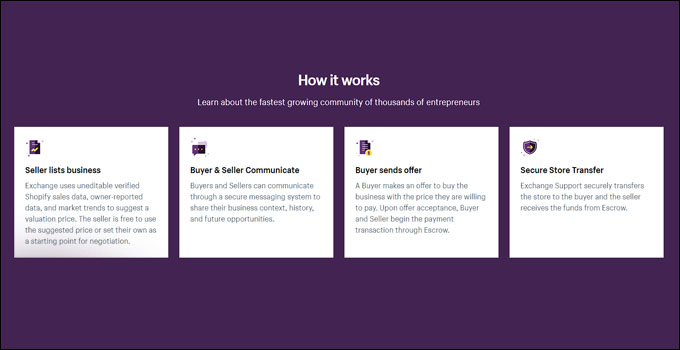The Exchange Marketplace, powered by Shopify, is a popular market for people to sell their eCommerce businesses. The marketplace is legitimate, with plenty of stores worth looking into.
However, as with any other platform, there are things you need to be aware of before rushing into an investment.
UPDATED: May 2024
Our Overall Rating
Overview of Shopify Exchange
As noted, the Exchange Marketplace is owned and managed by Shopify. All of the stores on the platform are Shopify stores, so if you’re looking for WooCommerce, Big Commerce, or sites built on other eCommerce platforms, you won’t find them here.
The marketplace operates similarly to other popular website marketplaces like Flippa and Empire Flippers. The layout shares many standard features, and the process for both buyers looking for websites on the platform, and sellers looking to post their sites, is similar in many ways.
For Sellers
Shopify has made it easy to list your store through an app that you can connect to your Shopify website. The app will pull in all necessary information, such as sales data and analytics, and then create a listing. Once this information has been compiled and you’ve filled out all of the other essential details, you can publish your listing and wait for approval to go live.
As noted previously, only Shopify stores can install the app and create a listing on the marketplace. Aside from that, your store must meet a few different requirements. Some of these, according to the Exchange Marketplace help documents, include:
- Your Shopify account needs to be on a paid or development plan. This includes Shopify’s Pause and Build online store plan.
- If you use Shopify Payments, your account needs to be in good standing. If your business has been removed from Shopify Payments, you can’t list your business on Exchange.
- If you’ve ever used Shopify Balance on your store, you can’t list your store on Exchange.
- You can’t have any open tickets with the Shopify Risk team, the Shopify Recovery team, or the Shopify Legal team. Any outstanding issues need to be resolved before you can list your store for sale.
There are other requirements to list your Shopify store on the Exchange Marketplace, so you must make sure you comply. Once your store has been approved, the marketplace provides many of the benefits of other platforms, including anonymous messaging, escrow payments, and secure migration to the buyer, all meant to protect you as a seller.
For Buyers
Individuals looking to buy Shopify stores can benefit from the Exchange Marketplace’s wide selection. The marketplace can have thousands of stores available for sale at any time.
One thing to note is that buyers on the Shopify Exchange need to conduct comprehensive due diligence. While sales and analytics of all websites are verified, things like traffic sources and profit margins or expenses aren’t. This means a website can look good from the revenue and traffic side of things but be a poor choice due to various factors like low margins and non-diversified traffic.
Types of Businesses Shopify Exchange Sells

Almost any Shopify website can be sold on the Shopify Exchange Marketplace, so long as it meets all stated criteria. This means all of the types of businesses on the marketplace fall into one of the various types of eCommerce sites.
Dropshipping Businesses
Dropshipping is a business model where a store owner will sell goods that a manufacturer or wholesaler is fulfilling. The Shopify Exchange Marketplace has various options for dropshipping stores, including stores set up with specific apps such as Modalyst or Spocket.
You can typically find multiple dropshipping stores on the marketplace at any given time. These can make for good starter websites if you’ve never run an eCommerce store, as you don’t need to worry about managing inventory or handling fulfillment. Instead, you can focus on managing the website while learning the industry.
Print-on-Demand Stores
Print-on-demand is dropshipping that involves products like t-shirts, mugs, phone cases, etc. You can create your own designs, and the POD service you use will print these designs on specified merchandise whenever someone orders your products. The company is paid for the product and a percentage of the total sale for fulfillment.
Usually, there are a few print-on-demand websites on the Shopify Exchange Marketplace. These websites can be a good option if you’re a creative type who wants to get your work out there. POD websites are another good option if you don’t have previous eCommerce experience, as you can learn website management and customer service without extra hassles.
Stores with Inventory
Inventory-based stores have physical products that will require you to manage the storage of some kind, whether at home or in a warehouse. You will also need to manage fulfillment for all orders, process returns, and everything else involved with running an online eCommerce business.
Shopify stores with inventory can be more challenging to manage. For this reason, these are typically better if you already have experience operating a website as you won’t have as steep of a learning curve. It’s also essential to understand the niche as you take on more risk when acquiring inventory.
Established Businesses
Established businesses have an established customer base, substantial revenue, and monthly profits. These types of websites can be either inventory-based or dropshipping and print-on-demand websites. One thing common with all of them is they will generally come at a premium price.
It’s critical to conduct thorough due diligence before purchasing an established website. You want to make sure the website has a long history of returns covered over a rolling average. Some sellers will pump up the numbers of a website through paid ads for a few months and then sell the site based on the average.
Shopify Exchange Evaluation Process

Shopify Exchange has two different periods where a website goes through evaluation. First, before the website can be published on the marketplace, and then separately when a buyer is considering the website. The initial evaluation from the Exchange Marketplace will look at all of the information provided to ensure it’s accurate.
Because websites are listed through the Shopify Exchange app, everything from analytics to sales data is pulled in manually and can’t be altered. While this does prevent fraudulent data from being recorded, it doesn’t prevent someone from boosting up their store’s numbers in the months leading up to the sale to make the store look more profitable than it is.
This is where you will need to be extra diligent during the second evaluation stage. Because everything is done through Escrow, you will have an inspection period where you can look through everything to make sure it checks out. The minimum inspection period is three days, with the maximum inspection period allowed up to thirty days.
You will be responsible for working with the seller to agree on the inspection period. I recommend around five to six days for smaller websites and dropshipping sites. However, it’s critical to give yourself time to check through everything for larger websites or websites where inventory is involved. This includes all of the inventory you are purchasing.
Do not accept anything until you’ve had time to look over all the assets thoroughly. Remember, as soon as you mark everything as accepted in escrow, the money will be released to the buyer. At this point, you will no longer be able to bring up issues with the merchandise or website. Also, if you are looking at a niche that you’re unfamiliar with, I recommend bringing in an expert to consult on the matter, especially for high-value websites.
The specific process for buying and evaluating a website on the Shopify Exchange Marketplace is as follows:
- Find a listing that you’re interested in.
- Contact the seller.
- If the seller responds, send them an offer.
- The seller accepts the offer.
- The seller creates an escrow transaction.
- You are notified to agree to the terms and submit payment
- Escrow approves the transaction.
- Seller transfers all assets to you.
- Mark all assets as received in Escrow.
- Conduct a complete inspection of the website and all inventory during the given inspection period.
- Accept all assets in escrow.
- The Shopify Accounts team turns you from staff to the store owner within three business days. You will be notified once this ownership transfer has been completed.
- Funds will be transferred to the seller from the escrow transaction. At this point, the escrow transaction is finalized, and a refund or return is not possible.
Shopify Exchange Sales Process
The sales process with the Shopify Exchange Marketplace is pretty straightforward and, as noted above, comparable to other website marketplaces. For sellers, the platform provides benefits such as anonymous messaging, transactions through escrow, and secure transfers with multiple levels of verification required before the transfer can take place.
I recommend having all potential buyers sign a non-disclosure agreement for larger brands. This is especially true if you reveal any proprietary information during the evaluation period. Remember, potential buyers can reject the offer after inspecting the website and inventory. If this would reveal anything specific or unique about your systems or processes, an NDA is critical.
The exact process, as detailed by the help documents on the Shopify website, is as follows:
- Ensure you meet the listing eligibility requirements and have reviewed the Exchange Marketplace guidelines.
- Install the Exchange Marketplace app.
- Submit your listing for review.
- Once your listing has been reviewed, publish it.
- A buyer will contact you.
- You answer the buyer’s question.
- The buyer sends you an offer.
- You accept the offer, including the terms of the inspection period.
- You create the Escrow transaction in your Exchange app.
- The buyer is notified to accept the terms and submit payment to the Escrow transaction.
- You’re notified to transfer assets to your buyer.
- The buyer marks all assets as received in Escrow.
- The buyer inspects the item for accuracy.
- The buyer accepts all items in escrow.
- Your funds will be deposited into your bank account within five working days after disbursement from Escrow.
- The buyer becomes the new owner of the store within three business days. The Shopify Accounts Team makes sure that your billing and payment info is securely removed during this step.
- When the store ownership transfer is completed, you get an email confirmation.
Shopify Exchange Commission Fees & Pricing
One of the benefits of the Shopify Exchange Marketplace is that there are no fees to list your store on the platform. Instead, you only pay a service fee on the final sale price. This service fee is a combination of the escrow fee as well as the exchange fee and is calculated when you list your store.
This is different from many other website marketplaces that charge a flat commission on the sale price or a tiered sales fee structure. The only exception to this is Flippa which charges a listing fee and a success fee for the final sale price.
Shopify Exchange Success Rate & Credibility
First, because the Exchange is a part of Shopify, it has a high rate of credibility and can be trusted for buying and selling websites. However, compared to other website marketplaces such as Empire Flippers, I don’t believe they have as high of standards as any Shopify store, regardless of how long it’s been around or how much the sales are, is allowed to list.
It’s also hard to find a success rate for closing deals. Instead, all I could find after extensively searching were random testimonials from sellers on the website. There were also individuals on sites like Reddit who spoke about successfully selling their websites, but these unverified testimonials should be taken lightly.
4 Major Benefits of Shopify Exchange Marketplace

The Shopify Exchange Marketplace isn’t perfect, but it does have a few benefits that can’t be overlooked.
The Shopify Name
Of primary benefit is that the Exchange Marketplace has the Shopify name behind it. According to the website technology lookup tool Built With, at least 4 million websites were using the Shopify platform in 2022. With this many people actively building on the platform, it carries a high degree of trust and credibility.
VIP Mailing List
Mailing lists are not something unique to Shopify. Website marketplaces like Flippa and Empire Flippers also have them. However, the Shopify mailing list has over four hundred thousand people on their mailing list receiving information about new and active listings. If you’re looking to sell on the marketplace, this can go a long way towards helping you find the right customer at the price you’re asking.
Exchange App For Verification
One benefit for buyers is that all stores listed on the Shopify Exchange Marketplace have to be listed through the Exchange app. This app pulls in all information about sales and analytics, ensuring that sellers can’t just list whatever they want on the platform. This is one step further than many platforms, which rely on users to enter in data manually and then post screenshots for verification which, from my experience, can be easily altered.
Escrow Payment Process
A final benefit for both buyers and sellers is that all transactions are conducted through Escrow.com. This mitigates the risk of either the buyer or seller being able to scam one another. The buyer must deposit funds using the escrow platform before the seller transfers any inventory or digital assets for inspection. The buyer must be completely satisfied before approving the sale. If either party is not happy with the deal, the money is returned to the buyer, and the seller retains everything.
2 Major Drawbacks of Shopify Exchange
Despite the upsides of the Shopify marketplace, there are a few drawbacks that potential buyers and sellers should be made aware of before using the platform.
Some Information Must Be Verified Manually
In regards to the verification of the store, all analytics and sales data are verified through the Shopify Exchange app. However, things like profit margins, expenses, and traffic sources are up to the buyer to verify. The issue here is that a seller could create a new store and then use advertising, shady link practices, or other methods to boost traffic in the short term. They could also be buying their products to increase sales.
This would make a store less valuable as it hadn’t been proven stable over the long term. While I always recommend buyers conduct meticulous due diligence, it would be nice if there were a little more put into verification of stores to make sure everything checked out with sellers.
Site Overvaluation
Because Shopify is taking a percentage of the final sale, it’s in their best interest for sties to be valued as high as possible while still being reasonable enough to attract buyers. From the buyer’s perspective, you need to pay close attention to the asking price of a site. I recommend having an independent valuation for high-value sites to ensure you get a good deal.
FAQs About Shopify Exchange
To further help you understand if the Shopify Exchange Marketplace is the right option for you to buy or sell a Shopify store, here are answers to some of the most common questions about the platform.
Can you list non-Shopify stores on the Shopify Exchange Marketplace?
You cannot list non-Shopify stores on the Shopify Exchange Marketplace. The reason for this is that all stores listed on the platform must be verified through the Shopify Exchange app, which only works with Shopify. If you have a non-Shopify store, it can be listed on sites like Motion Invest and Empire Flippers.
Is buying a business on Shopify Exchange safe?
Buying a business on Shopify Exchange is safe for both buyers and sellers. Because transactions go through Escrow.com, everything must be approved by the buyer and seller before the money is released and the website transferred to the new owner. It’s also possible to have buyers and sellers sign NDAs for further protection.
Does Shopify Exchange charge a fee to the buyer?
There are no fees to the buyer on the Shopify Exchange Marketplace. Instead, the platform makes money through a percentage of the final sales price of the website. This is taken out of the seller’s side of the transaction.
How is a store’s value calculated on the Shopify Exchange Marketplace?
The value of all stores on the Shopify Exchange Marketplace are calculated using a few different methods. These metrics include a store’s lifetime revenue, traffic, social media followers, and email subscribers. However, the valuation does not calculate expenses, where traffic comes from, or similar essential metrics. You should use tools like Ahrefs or SEMrush to discover this information.
Verdict
Overall, the Shopify Exchange Marketplace is trustworthy. It can be a good place to sell your website if you have a starter Shopify store or lower sales volume. However, if you have an established business with a proven track record, you may find better luck on other exchanges such as Empire Flippers.
As a buyer, a few major issues require you to conduct extensive due diligence to ensure you buy a stable website. The main issue is that Shopify doesn’t use rolling averages to calculate a website’s profits. Someone can pump up the numbers for a few months with advertising or shady SEO methods and then sell it. The Shopify Exchange can be a good option for buyers looking for lower-cost websites. However, if you have the capital to work with, you may be better off on another platform.




